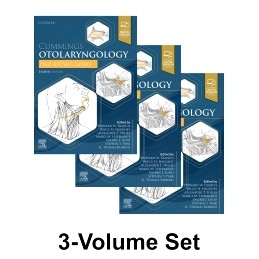- Reduced price
- New

Order to parcel locker

easy pay


 Delivery policy
Delivery policy
Choose Paczkomat Inpost, Orlen Paczka, DHL, DPD or Poczta Polska. Click for more details
 Security policy
Security policy
Pay with a quick bank transfer, payment card or cash on delivery. Click for more details
 Return policy
Return policy
If you are a consumer, you can return the goods within 14 days. Click for more details
Data sheet
Part I: Measuring Outcomes and Performance
1. Outcomes Research??
2. Interpreting Medical Data
3. Evidence-Based Performance Measurement
Part II: General Otolaryngology
4. History, Physical Examination, and the Preoperative Evaluation
5. General Considerations of Anesthesia and Management of the Difficult Airway
6. Surgical Management of the Difficult Adult Airway
7. Tracheotomy??
8. Overview of Diagnostic Imaging of the Head and Neck
9. Deep Neck and Odontogenic Infections
10. Head and Neck Manifestations in the Immunocompromised Host
11. Laryngeal and Tracheal Manifestations of Systemic Disease
12. Oral Manifestations of Systemic Diseases??
13. Otolaryngology in the Elderly
14. Pain Management in the Head and Neck Patient
15. Sleep Apnea and Sleep Disorders
Part III: Facial Plastic and Reconstructive Surgery
Section 1: Facial Surgery
16. Aesthetic Facial Analysis
17. Recognition and Treatment of Skin Lesions
18. Scar Revision, Keloids, and Camouflage
19. Facial Trauma: Soft Tissue Lacerations and Burns
20. Maxillofacial Trauma
21. Reconstruction of Facial Defects
22. Hair Restoration: Medical and Surgical Techniques
23. Management of Aging Skin
24. Rhytidectomy and Facial Liposuction
25. The Aesthetic Brow and Forehead
26. Blepharoplasty
27. Mentoplasty
28. Otoplasty
Section 2: Rhinoplasty
29. The Nasal Septum
30. Nasal Fractures
31. Rhinoplasty
32. Special Rhinoplasty Techniques
33. Non-Caucasian Rhinoplasty
34. Revision Rhinoplasty
Part IV: Sinus, Rhinology and Allergy/Immunology
35. Allergy and Immunology of the Upper Airway
36. Olfactory function and dysfunction
37. Objective Assessment of Nasal Function
38. Imaging of Nose and Sinuses
39. Non-allergic Rhinitis
40. Acute Rhinosinusitis: Pathogenesis, Treatment and Complications
41. Pathogenesis of Chronic Rhinosinusitis
42. Chronic Rhinosinusitis: Evidence based Medical Treatment
43. Chronic Rhinosinusitis: Outcomes of Medical and Surgical Treatment
44. Primary Sinus Surgery
45. Causes of Failure, Revision Surgery for Rhinosinusitis, and Management of Complications in Endoscopic Sinus Surgery
46. Management of the Frontal Sinuses
47. Epistaxis
48. Cerebrospinal Fluid Rhinorrhea
49. Sino-orbital Interface
50. Benign Tumors of the Sinonasal Tract
51. Systemic Disease of the Nose and Sinuses
52. Facial Pain
Part V: Laryngology and Bronchoesophagology
53. Laryngeal and Pharyngeal Function
54. Visual Documentation of the Larynx
55. Voice Evaluation and Therapy
56. Neurologic Evaluation of the Larynx and Pharynx
57. Neurologic Disorders of the Larynx
58. The Professional Voice
59. Laser Surgery: Basic Principles and Safety Considerations
60. Benign Vocal Fold Mucosal Disorders
61. Acute and Chronic Laryngopharyngitis
62. Medialization Thyroplasty
63. Arytenoid Adduction and Abduction
64. Laryngeal Reinnervation
65. Chronic Aspiration
66. Laryngeal and Esophageal Trauma
67. Surgical Management of Upper Airway Stenosis
68. Diseases of the Esophagus
69. Transnasal Esophagoscopy
70. Zenker Diverticulum
71. Tracheobronchial Endoscopy
Part VI: Head and Neck Surgery and Oncology
Section 1: General Considerations
72. Fundamentals of Molecular Biology and Gene Therapy
73. Biology of Head and Neck Cancers
74. Human Papillomavirus (HPV) and the Epidemiology of Head and Neck Cancer
75. Radiotherapy for Head and Neck Cancer: Radiation Physics, Radiobiology, and Clinical Principles
76. Chemotherapy and Targeted Biologic Agents for Head and Neck Cancer
77. Skin Flap Physiology and Wound Healing
78. Free Tissue Transfer
79. Integrating Palliative and Curative Care Strategies in the Practice of Otolaryngology
80. The Management of Cutaneous Head and Neck Melanoma
Section 2: Salivary Glands
81. Physiology of the Salivary Glands
82. Diagnostic Imaging and Fine-needle Aspiration of the Salivary Glands
83. Inflammatory Disorders of the Salivary Glands
84. Benign Neoplasms of the Salivary Glands
85. Malignant Neoplasms of the Salivary Glands
Section 3: Oral Cavity
86. Physiology of the Oral Cavity
87. Oral Mucosal Lesions
88. Odontogenesis, Odontogenic Cysts, and Odontogenic Tumors
89. Temporomandibular Joint Disorders
90. Benign Tumors and Tumor-like Lesions of the Oral Cavity
91. Malignant Neoplasms of the Oral Cavity
92. Reconstruction of the Mandible and Maxilla
93. Prosthetic Management of Head and Neck Defects
94. Malignancies of the Paranasal Sinus
Section 4: Pharynx and Esophagus
95. Benign and Malignant Tumors of the Nasopharynx
96. Malignant Neoplasms of the Oropharynx
97. Transoral Approaches to Malignant Neoplasms of the Oropharynx
98. Reconstruction of the Oropharynx
99. Swallowing Function and Implications in Head and Neck Cancer
100. Diagnostic Imaging of the Pharynx and Esophagus
101. Neoplasms of the Hypopharynx and Cervical Esophagus
102. Radiotherapy and Chemotherapy of Squamous Cell Carcinomas of the Hypopharynx and Esophagus
103. Reconstruction of the Hypopharynx and Esophagus
Section 5: Larynx
104. Diagnostic Imaging of the Larynx
105. Malignant Tumors of the Larynx
106. Management of Early Glottic Cancer
107. Transoral Laser Microresection of Advanced Laryngeal Tumors
108. Conservation Laryngeal Surgery
109. Total Laryngectomy and Laryngopharyngectomy
110. Radiation Therapy for Cancer of the Larynx and Hypopharynx
111. Vocal and Speech Rehabilitation After Laryngectomy
112. Diagnosis and Management of Tracheal Neoplasms
Section 6: Neck
113. Differential Diagnosis of Neck Masses
114. Ultrasound Imaging of the Neck
115. Neoplasms of the Neck
116. Lymphomas Presenting in the Head and Neck
117. Radiation Therapy and Management of the Cervical Lymph Nodes and Malignant Skull Base Tumors
118. Neck Dissection
119. Complications of Neck Surgery
120. Penetrating and Blunt Trauma to the Neck
Section 7: Thyroid/Parathyroid
121. Disorders of the Thyroid Gland
122. Management of Thyroid Neoplasms
123. Management of Parathyroid Disorders
124. Surgical Robotics in Otolaryngology
125. Management of Thyroid Eye Disease (Graves Ophthalmopathy)
Part VII: Otology, Neurotology, and Skull Base Surgery
Section 1: Basic Science
126. Anatomy of the Temporal Bone, External Ear, and Middle Ear
127. Neuroanatomy of the Auditory System
128. Physiology of the Auditory System
129. Anatomy of the Vestibular System
130. Anatomy and Physiology of the Eustachian Tube
131. Clinical Evaluation and Management of the Eustachian Tube
132. Cortical Neuroplasticity in Hearing Loss
133. Geriatric Otology: Population Health and Clinical Implications
Section 2: Diagnostic Assessment
134. Diagnostic Audiology and Electrophysiologic Assessment of Hearing
135. Neuroradiology of the Temporal Bone and Skull Base
136. Interventional Neuroradiology of the Skull Base, Head and Neck
137. Otologic Symptoms and Syndromes
Section 3: External Ear
138. Infections of the External Ear
139. Topical Therapies of External Ear Disorders
Section 4: Middle Ear, Mastoid and Temporal Bone
140. Chronic Otitis Media, Mastoiditis, and Petrositis
141. Complications of Temporal Bone Infections
142. Tympanoplasty and Ossiculoplasty
143. Mastoidectomy: Surgical Techniques
144. Middle Ear Endoscopic Surgery
145. Clinical Assessment and Surgical Treatment of Conductive Hearing Loss
146. Otosclerosis
147. Management of Temporal Bone Trauma
Section 5: Inner Ear
148. Cochlear Transduction and the Molecular Basis of Auditory Pathology
149. Genetics of Ear Disorders
150. Genetic Sensorineural Hearing Loss
151. Otologic Manifestations of Systemic Disease
152. Sensorineural Hearing Loss in Adults
153. Tinnitus and Hyperacusis
154. Noise-Induced Hearing Loss
155. Infections of the Labyrinth
156. Autoimmune Inner-Ear Disease
157. Vestibular and Auditory Ototoxicity
158. Pharmacologic and Molecular Therapies of the Cochlear and Vestibular Labyrinth
Section 6: Auditory Prosthetic Stimulation, Devices, and Rehabilitative Audiology
159. Implantable Hearing Devices
160. Cochlear Implantation: Patient Evaluation and Device Selection
161. Medical and Surgical Considerations in Cochlear Implantation
162. Cochlear Implantation in Adults: Results, Outcomes and Rehabilitation
163. Auditory Brainstem Implantation
164. Hearing Aid Amplification
Section 7: Vestibular Disorders
165. Principles of Applied Vestibular Physiology
166. Evaluation of the Patient with Dizziness
167. Peripheral Vestibular Disorders
168. Central Vestibular Disorders
169. Surgery for Vestibular Disorders
170. Vestibular and Balance Rehabilitation Therapy: Program Essentials
Section 8: Facial Nerve Disorders
171. Tests of Facial Nerve Function
172. Clinical Disorders of the Facial Nerve
173. Intratermporal Facial Nerve Surgery
174. Rehabilitation of Facial Paralysis
Section 9: Cranial Base
175. Surgical Anatomy of the Lateral Skull Base
176. Surgery of the Anterior and Middle Cranial Base
177. Transnasal Endoscopic-Assisted Surgery of the Anterior Skull Base
178. Temporal Bone Neoplasms and Lateral Cranial Base Surgery
179. Neoplasms of the Posterior Fossa
180. Intraoperative Monitoring of Cranial Nerves in Neurotologic Surgery
181. Radiation Therapy of Benign Tumors of the Cranial Base
Part VIII: Pediatric Otolaryngology
Section 1: General
182. General Considerations in Pediatric Otolaryngology
183. Pediatric Speech Disorders
184. Anesthesia in Pediatric Otolaryngology
185. Nonobstructive Pediatric Sleep Disorders
186. Evaluation and Management of Pediatric Obstructive Sleep Apnea
Section 2: Craniofacial
187. Craniofacial Surgery for Congenital and Acquired Deformities
188. Cleft Lip and Palate
189. Velopharyngeal Dysfunction
190. Congenital and Acquired Malformations of the Nose and Nasopharynx
191. Pediatric Facial Fractures
Section 3: Hearing Loss and Pediatric Otology
192. Pediatric Otologic Surgery
193. Early Detection and Diagnosis of Infant Hearing Impairment
194. Congenital Malformations of the Inner Ear
195. Microtia Reconstruction
196. Pediatric Cochlear Implantation
197. Evaluation and Management of Congenital Aural Atresia
198. Evaluation and Management of Pediatric Vestibular Disorders
Section 4: Infections and Inflammation
199. Acute Otitis Media and Otitis Media with Effusion
200. Pediatric Chronic Rhinosinusitis
201. Pediatric Infectious Disease
Section 5: Head and Neck
202. Congenital and Inflammatory Neck Masses in Children
203. Vascular Anomalies of the Head and Neck
204. Pediatric Head and Neck Neoplasms
205. Salivary Gland Disease in Children
Section 6: Pharynx, Larynx, Trachea and Esophagus
206. Evaluation and Management of the Pediatric Airway
207. Tongue-Ties and Lip Ties
208. Recurrent Respiratory Papillomatosis
209. Glottic and Subglottic Stenosis and Related Voice Disorders
210. Diagnosis and Management of Tracheal Anomalies and Tracheal Stenosis
211. Aerodigestive Foreign Bodies and Caustic Ingestions
212. Pediatric Swallowing, Laryngopharyngeal and Gastroesophageal Reflux Disease, Eosinophilic Esophagitis, and Aspiration
213. Pediatric Tracheotomy and Decannulation
214. Laryngotracheal Clefts
Reference: 92074
Author: Kerry H. Cheever
Reference: 92759
Author: Nancy J. Cibulka
Reference: 59965
Author: Baha Al-Shaikh
Reference: 95962
Author: Gautam N Allahbadia
Reference: 11225
Author: Agnieszka Domańska-Jakubowska
Niepełnosprawność w aspekcie medycyny pracy - wybrane zagadnienia
